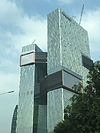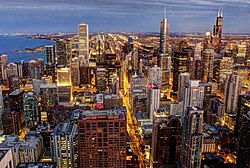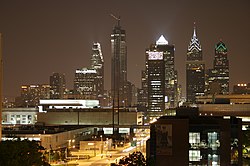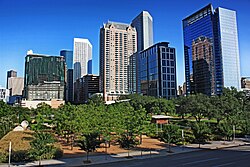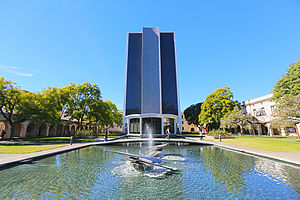Halland: Difference between revisions
| Line 234: | Line 234: | ||
{| class="wikitable sortable" | {| class="wikitable sortable" | ||
|- | |- | ||
!Image | !Image | ||
!Name | !Name | ||
| Line 241: | Line 240: | ||
!Notes | !Notes | ||
|- | |- | ||
| [[File:Tencent_Binhai_Mansion.jpg|100px]] | | [[File:Tencent_Binhai_Mansion.jpg|100px]] | ||
| Bain & Walsh | | Bain & Walsh | ||
| Line 255: | Line 246: | ||
| Multinational insurance and financial services holding | | Multinational insurance and financial services holding | ||
|- | |- | ||
| | | [[File:Werk_Sindelfingen_aerial.jpg|100px]] | ||
| Astoria Motor Group | |||
|align="right"| $201,924 | |||
|align="right"| 414,251 | |||
| Automotive Industry Conglomerate | |||
|- | |||
| [[File:Midpoint_Nokia_Karaportti.jpg|100px]] | | [[File:Midpoint_Nokia_Karaportti.jpg|100px]] | ||
| Transoft | | Transoft | ||
| Line 262: | Line 258: | ||
| Technology Company specialized in microelectronics, computers and smartphones | | Technology Company specialized in microelectronics, computers and smartphones | ||
|- | |- | ||
| [[File:Wedding_Fennstraße_Scherig-Hochhaus.JPG|100px]] | | [[File:Wedding_Fennstraße_Scherig-Hochhaus.JPG|100px]] | ||
| Aylin Holding Intl. | | Aylin Holding Intl. | ||
| Line 269: | Line 264: | ||
| Multinational pharmaceutical and chemical industrial conglomerate | | Multinational pharmaceutical and chemical industrial conglomerate | ||
|- | |- | ||
| [[File:Airbus_Lagardère_-_Aéroconstellation.jpg|100px]] | | [[File:Airbus_Lagardère_-_Aéroconstellation.jpg|100px]] | ||
| EXCAL | | EXCAL | ||
Revision as of 18:21, 31 March 2020
This article is incomplete because it is pending further input from participants, or it is a work-in-progress by one author. Please comment on this article's talk page to share your input, comments and questions. Note: To contribute to this article, you may need to seek help from the author(s) of this page. |
Commonwealth of Halland Commonwealth of Halland Comhlathas na Tìr Hael | |
|---|---|
Motto: Sic semper tyrannis Thus always to tyrants | |
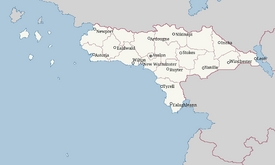 Political map of Halland | |
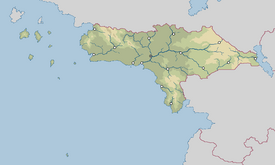 Physical map of Halland | |
| Capital | Avelon |
| Largest city | Astoria |
| Recognised national languages | Estmerish Ghailish |
| Recognised regional languages | Powhatan |
| Demonym(s) | Hallandic |
| Government | Unitary semi-presidential republic |
• President | Arthur Quinn |
• Prime Minister | Sean Mac Dónaill |
| Senate | |
| National Assembly | |
| Establishment | |
• Colonisation by Estmere and Caldia | 1492 |
• Gilded Wars | 1721 |
• Declaration of Independence | 1764 |
| Area | |
• | 1,831,549.44 km2 (707,165.19 sq mi) |
| Population | |
• 2015 census | |
| GDP (PPP) | 2019 estimate |
• Total | |
• Per capita | |
| GDP (nominal) | 2019 estimate |
• Total | |
• Per capita | |
| Gini (2015) | medium |
| HDI (2015) | very high |
| Currency | Pound (HLP) |
| Date format | dd.mm.yyyy |
| Driving side | right |
| Internet TLD | .hl |
Halland is a country in Asteria Superior, bordered by Cassier in the north, Nuxica in the south and the Vehemens Ocean to the west. It also shares a lake border with Chervolesia. The country is subdivided in 19 administrative regions, which cover an area of 1,831,549.44 square kilometers, making it the fifth largest state in Asteria. Halland is a unitary parliamentary republic with its capital in Avelon. Its largest city and main commercial center is Astoria, located on the northern coast of the nation. Other major cities include Ealaghleann, Stokes and Leon. Estmerish is the official language, although in the Fáel region, Ghailish enjoys co-official status.
Indigenous Powhatan people inhabited the country for thousands of years prior to colonization. Assim Asteris and his expedition sponsored by Caldia discovered the continent in 1488, marking the beginning of colonization of the region by Euclean nations. Caldia soon after created its colony, Fáel, in the south of Halland. Soon after, Estmere established the colony of New Estmere to the north. Both colonies would grow prosperous, with the city of Astoria becoming a major port in the continent in the 17th century. Both colonies would be conquered by Gaullica during the Gilded Wars of 1721. The new administration sponsored many policies which sparkled significant unrest, leading to various failed independence attempts and culminating in the 1764 War of Independence. Since then, Halland grew economically and became an important power in Asteria Superior, industrializing rapidly in the early 19th century and receiving many migrants. Halland was an important player in the Great War, achieving significant naval victories against Gaullica and aiding on the liberation of Nuxica.
In modern times Halland is a cosmopolitan nation with populations of a very diverse background. It is the fourth largest economy in the world by nominal GDP and the largest economy in Asteria. The nation has a significant international presence, being host of the Organization of Asterian Nations, one of the founding members of the CN, an observer member in COMSED and one of the founders of the ICD. Halland is considered a developed nation, with high standards of living and an advanced economy.
History
Pre-colonial era
The territory that is now Halland shows archaelogical sites tracing back to 10,000 BC. These archaeological sites show signs of sedentary lifestyle, writing and complex tools dating as far back as 6000 BC. Several native ethnicities inhabited the nation's coast and interior, most notably the Nehinaw and Powhatan cultures. It is estimated that before the arrival of euclean colonists, roughly 5 million natives inhabited the lands that are now Halland. The majority adopted semi-nomadic lifestyles, though sedentary behaviour along the coast was a notable feature of the Nehinaw.
Prior to Euclean arrival, the Nehinaw controlled a significant portion of Halland's inner coast, with an organized bureaucracy, permanent settlements and a sedentary lifestyle. The Nehinaw tribes were loosely centralized under a High Chieftain, which rotated from among the chieftains of three of the major tribes. On first contact, Euclean explorers were met by the Nehinaw, who imprisoned the eucleans and held them captive for three weeks. There, the explorers were able to codify the Nehinaw culture and life in Nitassinan, one of their largest permanent settlements located in the vicinity of present-day New Warminster. The city was divided in twelve districts each with twelve large communal houses suited for twenty families each and smaller habitations and temporary tents for visitors from other settlements, as well as small patches of farmland. At the center of the city was another large communal house, where the chieftain, his family and other families of prestige lived. In total, it was estimated that the city was home at least 25,000 inhabitants.
The Nehinaw frequently had conflict with other tribes, such as the Wyandot people in the north, with whom they had frequent conflict. The Wyandot confederated to protect against Nehinaw expansion, fighting numerous wars against them. To the east, the Powhatan tribes also exerted pressure on the Nehinaw, with surviving exerpts of text from the Nehinaw discussing the "savage nature of the uncivilized Powhatan". The Powhatan tribes adopted a semi-nomadic lifestyle to the east, centered around their holy cities along the Weanoke river. The Powhatan made extensive use of mounds in the construction of these holy settlements, which were intermittently inhabited following the harvest seasons. After harvest, tribes adopted nomadic styles, hunting and gathering through the Eastern Plateau.
The pre-assimian era in Halland was marked by significant clashes between the area's tribes, originated by ethnic, religious and cultural differences.
Estmerish and Caldish colonization
Gaullican Administration
Independence and expansion
Industrialization and the Great War
Contemporary Era
Geography
Climate
Biodiversity
Urbanisation
Politics
Government

|
File:Official Portrait of Kentucky Governor Andy Beshear (cropped).jpg |
| Arthur Quinn President since 2016 |
Sean Mac Dónaill Prime Minister since 2018 |
Halland is a unitary semi-presidential republic with a very strong democratic tradition since its foundation. Despite being a unitary state, Halland features significant levels of devolution, with regions enjoying varying levels of autonomy. The most notable of which is the Fáel region, which has a parliament of its own and devolution of significant powers under said parliament.
The nation's legislative power is a bicameral legislature, composed of the Senate and the National Assembly is responsible for approving national law, ratifying treaties, approving the yearly national expenditure and declaring war. The legislature also has power of Impeachment, as well as appointing a Prime Minister, who is the country's Head of Government.
Executive power is divided between the President, who is Head of State. and Prime Minister. While most executive power is exercised by the Prime Minister through appointed Ministers, the President is Commander-in-chief of the Armed Forces, can veto legislative proposals before they become law, and is in charge of foreign policy, representing the country diplomatically in international summits and events.
The judiciary is represented in its highest level by the Supreme Court and its lower instances. Ministers of the Supreme Court are appointed by the President, and are responsible for interpreting laws and their rulings are binding upon all lower courts. They also hold the power of retrial and can also reject laws considered unconstitutional. It is composed of 9 Ministers. Other than the Supreme Court, the Fáel Region also has the Superior Court of Fáel, which acts an intermediate court instance between conventional judicial instances and the Supreme Court. Regarding laws approved by the Parliament of Fáel, it also is not subject to further review by the Supreme Court.
Halland's Lower House, the National Assembly, is composed of 639 seats, which are elected to serve for 4 years. Elections for the National Assembly are done through Proportional Representation, where each of the 19 administrative regions are granted a seat per 100,000 inhabitants. The Senate has 76 voting members, with four senator seats given to each administrative region. Senators are elected through Single Transferable Vote, where each voter may list four candidates in order of preference. Election terms for the Senate last 8 years, with half the Senate elected every four years. Presidential elections happen every four years, and an elected president may be reelected no more than once. The Prime Minister is not elected, instead being chosen from the coalition most likely to form majority.
Each of the 19 Administrative Regions feature varying levels of autonomy and different systems of organization based on the 1988 Statute of Devolution. The Fáel Region has a Parliament of its own, organized in an unicameral legislature. Since the statute of Devolution, all Administrative Regions have elections in place for Governors, which have varying degrees of autonomy. Halland's current constitution was approved in 1948, extending local autonomy and increasing the powers of the legislative over the executive. It has since then received several amendments such as the aforementioned Statute of Devolution. Amendments must be approved with a qualified majority by both National Assembly and Senate.
Halland's modern political environment is protagonized by four major political parties: The Union Party (UP), the Liberal Republicans (LR), the Social Democratic Party (SDP) and the Fáelian Conservative Union (FCU). The first three parties represent nation-wide movements and traditions of conservatism, liberalism and social democracy respectively. The FCU is predominant in the Fáel region, being largely associated with the Union Party at a national level. Recently, the Green Party has gained relevance, rising in representatives both in Halland's National Assembly and Senate. The Green Party has achieved its first prefecture in 2016, in Tyrell.
Devolved Administrations
The history of devolution in Halland dates back to independence, with the unification of New Estmere and Fáel in a single nation following independence from Gaullica. The wartime United Confederacy had then been transformed onto a federation . Management was considerably decentralized, with the Federal Government in Avelon having little power and autonomy over the federal entities below it. Following the (TBD WAR) in 1822, Halland's federal system was put in check, resulting in a new constitution with a strong unitary state and a statute of devolution for Fáel, which gave it rights similar to its prior federal status. Halland's Unitary State was once again questioned after the Great War, and in 1948 Halland's current constitution was put in place. The new constitution increased regional autonomy to some degree, yet Fáel remained the only devolved region. The Statute of Devolution of 1974, established to address demands of local autonomy due to the nation's increasingly decentralization of its urban population and the recognition of demographic groups previously not contemplated by the right of devolution, such as Halland's 4.2 million Native Asterians.
As per the Statute of Devolution, Halland is divided in 19 administrative constituencies, each with their own particularities. Halland's constituencies each have a different term of autonomy, voted on by the national parliament, the regional parliament and confirmed by referendum among region citizens. As per the Statute, national responsibility is delegated onto regional administration on a case by case basis, with the regional and national governments jointly agreeing upon a division of tasks adequate to the constituency's needs, historical background and strategic interests. Prior to 1974, only the Fáel Administrative Region featured devolution, whereas remaining regions lacked meaningful autonomy.
All Constituencies regardless of status have a legislature, which enjoy limited legislative capacities on varying levels, based on the Term of Devolution of said Constituency. Constituencies are each free to decide the organization of such legislature and electoral system, provided it respects the guaranteed democratic rights of the constitution. Constituent Councils are all under the legislative precedency of Halland's National Assembly, meaning laws approved by a Constituent Council may not override national law. An exception to this is the Faelian Parliament, whose term of devolution precedes that of any other state and is in effect since 1822. The Fael Constituency enjoys significant autonomy when compared to the others, able to override national parliament laws as long as they are constitutional. Each constituency must also elect, directly or indirectly, a head of government, responsible for regional management. The autonomy of this head of government is also dependent on the Term of Devolution, ranging from shared administration of assets in particular areas with the national government to full autonomy and management of government assets in most areas.
The peculiarity of Fáel's Term of Devolution arises from its status as a different colony prior to independence. Fáel and New Estmere were artificially unified by the Gaullican administration and after the independence efforts, both nations remained together. Following Halland's defeat in the (TBD WAR), an increased push for a more centralized government capable to exert its influence and organize itself was championed by the Estmerish-Hallandic peoples, which sparked an increased secessionist sentiment. This was solved through Fáel's Term of Devolution, which granted it significant autonomy and is still the same agreement Fáel has with the Hallandic state to this day. Fáel's legislature enjoys significantly more autonomy, its own Gendarmerie and a much wider control of the region's own budget. Ghailish is the official language in Fáel, with Estmerish being co-official, as well as many other particularities. The State still has control over certain assets, such as parts of the infrastructure network, hospitals and certain universities.
Law
Halland's legal system operates under civil law, with the legal core principles written in the country's current constitution, which entered effect in 1948. This legal system is traditional to Halland and has been in place since the nation's independence.
Foreign Relations

Halland is a founding member of the Northern Vehemens Organization, a founder of the CN, an observer member of COMSED and a member of the ICD. The nation has close diplomatic ties with Estmere, being considered its largest ideological and historical partner. A member of the Grand Alliance during the Great War, Halland has since then established a vast network of allies globally, notably Nuxica and Cassier, its main strategic partners. Valentir, Senria, Lainan, Garambura and Imagua are also notable allies of Halland internationally. Halland is considered a hub of international relations in Asteria, being the hosting nation of the OAN and the headquarters of various other organizations such as the Asterian Bank for Development.
Halland has extensive military presence abroad. It is part of various treaties of military cooperation abroad and a major international supplier of armament. Additionally, it supplies extensive economic aid to countries abroad, especially in Bahia, through the ABD, as well as supplying and partaking in various peacekeeping missions of the CN. Halland is one of the top donors in the world, with 0.37% of its GDP directed towards foreign development aid. This is mostly done through the ABD, an institution famous for extensive support of large scale projects and zero interest loans with the objective of consolidating rule of law, democracy and enforce human rights in developing nations.
Military
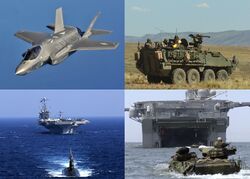
The Commonwealth Armed Forces are the the military forces of Halland, with the President as its commander-in-chief. They are divided in 4 branches, also known as arms: The Army, the Navy, the Air Force and the Marines. Halland is among the largest armed forces in the world. Halland has emerged in the Great War as the leading naval power in the Asterias, with a capable blue water navy capable of operating globally together with the nation's allies.
While not a nuclear state, Halland houses Nuxican nuclear warheads in its arsenals, with both land and air launch capability. The use of these warheads requires authorizations of both Nuxica and Halland jointly. Halland, despite its nuclear sharing agreement established in 1965 due to the worsening of relations with Chistovodia, has an ideological policy against nuclear weapons. While criticized to this day by certain right-wing parties, the government cancelled its nuclear weapon program in 1958, despite having a functioning bomb prototype. Halland however continued its research on nuclear propulsion, and is a leading power in nuclear propulsion and energy generation. It is considered a nuclear-latent power, with capacity to quickly develop nuclear warheads.
Halland has one of the largest military industrial complexes in the world, with one of the most competitive naval and airspace sectors. Among the technology developed in Halland are the F2000, a highly advanced multi-role fighter jointly developed with Estmere, Senria and Valentir, the Oberon-Class submarine, one of the most advanced and silent attack submarines in the world, the SASM, a highly advanced supersonic anti-ship missile, among others. Halland cooperates extensively with its allies and participates in several technology sharing programs with its military industrial complex. Halland is a significant exporter of defence equipment, supplying nations like Cassier, Estmere, Valentir and Garambura, as well as many others.
Halland has active military outside its borders, with the country notably being responsible for defence of Imagua. The country also has bases in Lainan and shares naval bases with Estmere. Halland participates in a number of international exercises with nations in and outside the North Vehemens Organization. Currently, Hallandic forces are deployed in Lainan, Imagua and Nuxica.
Economy
Halland is the largest economy in the Asterias, with a nominal GDP of $2.65 trillion. It is ranked the 4th largest economy in the world by nominal GDP and the 6th largest by Purchasing Power Parity. Private enterprise is extensive, with the nation being amongst the freest to do business with in Asteria. It has an unemployment rate of 4.7% and enjoys high labour productivity. Halland's development is centered along its coast, with Astoria being a notable global city.
Halland's economic growth has been steady ever since the 2005 crisis, with the country's economy growing by 3.6% in 2019, the largest growth since 2008. Halland is one of the largest importers of goods in Asteria, and the second largest exporter of goods in the continent. The nation has an extensive network of free trade agreements with the EC, Valentir, COMSED and other nations, as well as being one of the founding members of the Pan-Asterian Treaty for Cooperation and Defence, which also created a free-trade zone between Halland, Nuxica and Cassier.
Halland was the first nation to industrialize in Asteria, with the country achieving impressive economic growth and expansion following its independence from Gaullica. Astoria grew significantly and became an important industrial hub worldwide, and later so did Ealaghleann. The interior took longer to develop, with the government incentivizing an extensive rail network to connect the develop coast with the more rural interior. Stokes and later Leon have since then grown to become important development nodes in the hinterlands. Recent history has seen particular growth of population in the country's interior, due to reduced cost of living and availability of jobs. As a result, economic activity in the interior has increased significantly over the past decades.
Financial services are a significant sector of the economy, with the Astorian Stock Exchange being the largest in Asteria and one of the largest in the world. The services sector accounts for 70.9% of the economy, while the industrial sector composes 28.2% and agriculture 0.9% of GDP. Halland remains an industrial nation, although the country is deindustrializing at a fast rate in base industry. The automotive, electronic, naval, chemical and airspace industries are potent in Halland, being one of the most competitive in the world. The government owns significant shares in the airspace, energy and infrastructure sectors, with the country being considered by some to be a mixed economy. Recently, the government has been selling shares in several sectors of the economy, most notably the full privatization of HALCHEM, the country's largest petrochemical company, of which the government previously owned 40%, and the privatization of Hallair, the country's former nationally owned airline.
The government remains the leading employer in Halland, with 20.4% of employees working for the public sector. Labour movements in Halland are significant, with 64% of workers being unionized. As a result, worker's rights movements and negotiations are frequent. By law, Hallandic workers have one month paid vacation, guaranteed sick leave, extensive safety regulations, and a variety of other rights.
Halland is an exporter of agricultural products such as corn and wheat, with the country's food industry known worldwide. Halland is known for a diverse and internationally recognized varieties of cheeses, beers and cured meats. Beers, particularly of the Asterian Golden Ale and Asterian Wheat Beer are heavily exported, while internally different local varieties are consumed depending on region. Halland is known for its soft cow and goat milk cheeses, which have grown in popularity over the past decades. Hallandic Whiskey is also a significant luxury item exported worldwide.
Companies
Of the world's 500 largest companies, 31 are housed in Halland. Halland's biggest companies maintain key roles in the insurance and banking industries, as well as the chemical and pharmaceutical sectors. The airspace sector is also one of the most competitive in the world. Halland is one of the easiest nations in the world to create a business in, with average time to create a company being only 4 days. The nation has an extensive small business and startups sponsoring programs, which have thus far created 13 unicorn companies.
This list shows the 5 largest companies in Halland, as per their revenues reported in 2019.
Energy and Infrastructure
Tourism
Science and Technology
Demographics
Halland is the third most populous nation in Asteria Superior with a population of 63.8 million. It is the 17th most populous country in the world, with a population density of 35.6 inhabitants per square kilometer. Life expectancy at birth is 79.8 years for men and 82.1 years for women. It has a birth rate of 2.2 children born per woman, above the replenishment rate of 2.1. Halland's birth rate has begin to grow recently due to increased migration, having increased from 1.9 in 2005.
Halland can be divided in three major local demographic groups, tied to the country's history. The most populous demographic is of Estmerish background, originated from the settlers and colonists of New Estmere. In the Fáel region, the majority is of Ghailish ethnicity, originating from Caldish colonists. The country's interior is still home to significant native-asterian communities, mainly of the Powhatan tribes. While a minority in their administrative regions, they are a recognized and protected historical group in Halland, accounting for 4.6 million inhabitants of the country.
Halland is a very popular immigration destination, with significant historical communities having arrived from Euclea and Coius. The country's relatively simple immigration policy and sponsorship of qualified immigrations has made the nation a frequent choice amongst communities in developing countries, with 18.5% of the population being "of second-generation migrant" background. Halland is home to the largest Lainanese ethnic group outside of the country, as well as a significant Senrian community, a Gaullican community and many others, with immigrants from Bahian backgrounds numbering in the hundreds of thousands. Since the 50s, Bahio-Imaguans have grown a notable community, with roughly a hundred thousand Bahio-Imaguans in Halland. Recently, the number of migrants of Tsabaran origin have increased significantly due to the current civil war.
| Largest urban centers by population | |||||||
|---|---|---|---|---|---|---|---|
| # | Settlement | Population | # | Settlement | Population |
| |
| 1 | Astoria | 5,412,716 | 11 | Ealdwald | TBD | ||
| 2 | Ealaghleann | 3,243,217 | 12 | Ruyter | TBD | ||
| 3 | Avelon | 2,955,910 | 13 | Winchester | TBD | ||
| 4 | Stokes | 2,313,102 | 14 | Wilton | TBD | ||
| 5 | Leon | 1,915,851 | 15 | Inoka | TBD | ||
| 6 | Tyrell | 1,404,460 | 16 | Nikinapi | TBD | ||
| 7 | Ardougne | 1,092,081 | 17 | Ailynn | TBD | ||
| 8 | New Warminster | 908,922 | 18 | Beaver | TBD | ||
| 9 | Yanille | 815,504 | 19 | Fort Kellsen | TBD | ||
| 10 | Newport | 783,408 | 20 | Kitigan | TBD | ||
Education
Halland uses both public and private schools, with a primary, secondary, tertiary and technical school level. All schools in most of Halland are organized under the National Act of Education, which determines guidelines for education at primary and secondary levels. The Act is ammended by the Faelian parliament, where the educational structure is modified. While organized under the National Act, pre-schools and primary schools are managed at a provincial level, whereas a majority of secondary schools are managed by constituencies. Halland's national government is responsible for the funding and management of most universities.
While the education system starts with infant education (or preschool), education is only mandatory when students turn 5, when they start attending preschool. The following year, they begin to attend elementary school, where they continue their studies until they turn 11, when they begin to attend middle school (although in most parts of the country, they are considered two stages of elementary education). When students turn 15, they begin attending high school, and the following year, students decide whether to continue high school, or attend a technical school to enable students to directly enter the work force with further vocational expertise in a chosen field at age 18.
At the age of 18, students finish their mandatory education, and if they finished their high school education, can continue on to post-secondary education. Of the post-secondary institutions in Halland, there are 84 universities and 21 polytechnics in the entire country. Education in all public institutions from primary to tertiary level are completely free to students. Additionally, a number of privately-managed colleges and community colleges exist. Notably in Fael, public community colleges are widespread, providing technical education after secondary school. All public owned tertiary education institutions require participation in Halland's National Exam for Secondary Schools, or NESS, in order to be admitted. Grades in the NESS are ranked and used for students to choose their university of choice. The exam is also used to evaluate performance of schools all over the country.
Healthcare
Religion
Languages
Immigration
Culture
Art
Architecture
Cuisine
Halland's culinary culture is diverse, thanks to the country's many different communities. The country is known not only for traditional regional produce, such as cheeses, beers and fermented vegetables, but for an intense modern fusion cuisine scene in metropolitan environments, adapting traditional cuisine from Halland's migrant communities. Traditionally, Lai communities and Dezevauni migrants, who form the bulk of Halland's immigrant communities, have cemented themselves in urban settlements and brought much of their cuisine with them. Hallandic cuisine changed greatly in the 19th century, shaping itself beyond the traditional Euclean diet.
Halland's most common proteins are fish and pork, with beef being mainly imported. Both riverine and oceanic fish are important staples of Hallandic cuisine and overall seafood is considered the primary protein for special occasions. Pork and poultry are very common daily sources of protein, produced significantly locally. It is estimated that 11% of Halland follows a vegetarian diet, a proportion that has been rising recently.
A staple of Halland's cuisine and culinary lifestyle is the prevalence of regional open markets and street food. Large chains and retail markets have faced significant resistance in Halland and many had to adapt their business practices to compatibilize with Halland's consumption styles. Open Markets feature a diverse variety of local producers, especially in smaller cities and organic suppliers. The markets are also most known for urban street food vendors, which are popular amongst natives and tourists. Hallandic street food staples are barbecue eels, mangoes and spice, coconut breaded shrimp and a variety of stir fries.
Fermented foods are also a historic traditional staple in Halland, which traces back to pre-colonial periods. Fermentation has always been a characteristic practice for preservation of food, but its use for cuisine and its taste became more appreciated following the popularization of spices originated from Coius to Halland. Spicy fermented vegetables are common seasoning, and is growing in popularity internationally due to its healthy properties.
Halland's regional law features protected regulations for local produce, the most famous of which are the Winchester and Ruyter cheeses, and Fael Whiskey, exported worldwide. Each Constituency has specific protected labels which are recognized on national level, and local seals of quality are given to agricultural policy who meets adequate quality standards. Quality labelling in Halland is valued by consumers, and labels take into account the origin of produce, health standards of agriculture and food processing, traditional methods of production and labour standards.
Organic foods have been an increased concern in Halland, as well as humane treatment of animals. Due to consumer pressure and laws, business practices in the agricultural sector have recently taken a shift towards more humane production. A major political movement in Halland is the "Buy Local" campaign, which sponsors the consumption of food produced in the vicinity of individuals by small rural landowners. Large boycotts have been orchestrated against large food processing conglomerates in the past two decades, which have given even more life to Halland's traditional open markets.







